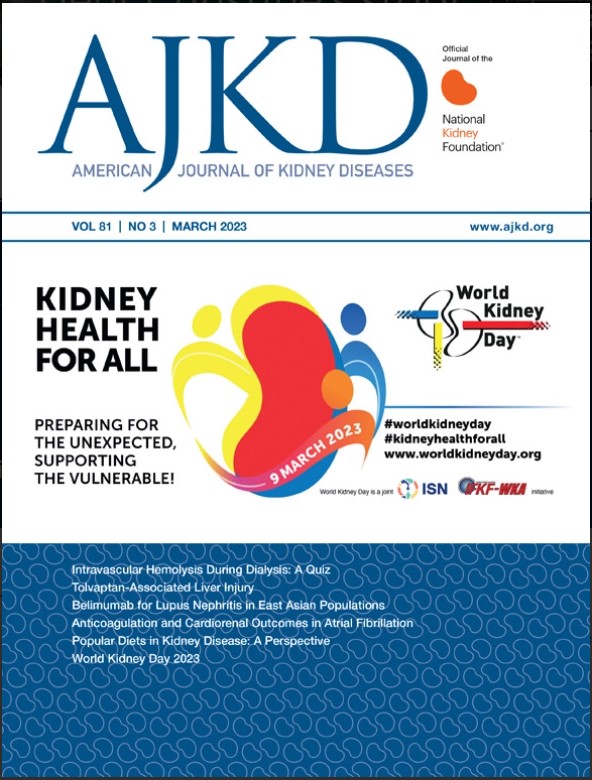性别与全因和特异性腹膜透析中止的关系。
IF 8.2
1区 医学
Q1 UROLOGY & NEPHROLOGY
引用次数: 0
摘要
理由与目的目前对性别与腹膜透析(PD)中止的具体原因之间的关系知之甚少。本研究旨在评估性别与全因和病因特异性PD停药的关系,并探讨这些关系的中介因素。研究设计回顾性队列研究。背景和参与者:澳大利亚2005-2019年间开始PD治疗的所有肾衰竭患者。结果:全因(转入血液透析≥30天或死亡)PD停药,与透析不充分相关的PD停药,与感染相关的PD停药。分析方法:采用调整后的病因特异性比例风险回归模型来评估性别与全因和病因特异性PD停药的关系。进行反事实中介分析,探讨这些关联的潜在中介因素(社会人口状况、地理位置偏远、心血管疾病、糖尿病、腹膜炎史、晚期转诊、吸烟状况和BMI)。使用Fine和Gray方法进行敏感性分析,以解决死亡、肾移植和其他PD停药原因的竞争风险。结果9748例患者中有6001例因任何原因出现pd停药(2098例死亡,793例透析不充分相关,1442例感染相关,1668例其他原因),中位随访时间为1.47年(IQR 0.67-2.73)。男性更有可能因任何原因(HR 95% CI) (1.09, 1.03-1.14, p=0.002)和不充分的透析(1.71,1.47-1.99,p<0.001)而出现PD中断(0.95,0.85-1.05,p=0.3)。中介分析发现,性别对全因PD停药的总影响中有76.9%是由中介因子解释的,包括心血管疾病、吸烟状况和糖尿病,而性别对透析不足导致PD停药的总影响中只有不到10%是由中介因子解释的。局限性:残留和未测量的混杂因素,如生物学差异、行为模式、住院、虚弱和合并症的严重程度。结论男性比女性更容易因任何原因和透析不充分而出现PD中断。这种关系是由任何原因的PD停药的多重发病率介导的,而不是由透析不充分引起的PD停药。这些发现可能为未来的研究提供信息,以评估可能导致这些观察到的性别差异的生物学和社会人口因素。本文章由计算机程序翻译,如有差异,请以英文原文为准。
Association of Sex With All-Cause and Cause-Specific Peritoneal Dialysis Discontinuation
Rationale & Objective
Little is known about the association between sex and specific causes of peritoneal dialysis (PD) discontinuation. This study assessed the association of sex with all-cause and cause-specific PD discontinuation and explored the factors mediating these relationships.
Study Design
Retrospective cohort study.
Setting & Participants
All patients with kidney failure who started PD between 2005 and 2019 in Australia.
Exposure
Sex.
Outcome
All-cause (transfer to hemodialysis for ≥30 days or death) PD discontinuation, PD discontinuation related to inadequate dialysis, and PD discontinuation related to infection.
Analytical Approach
Adjusted cause-specific proportional hazards regression models were used to assess the association of sex with all-cause and cause-specific PD discontinuation. Counterfactual mediation analysis was conducted to explore potential mediators (sociodemographic status, geographical remoteness, cardiovascular disease, diabetes, history of peritonitis, late referral, smoking status, and body mass index) of these associations. Sensitivity analyses using the Fine and Gray method were implemented to address the competing risks of death, kidney transplantation, and other causes of PD discontinuation.
Results
Of 9,748 incident patients, 6,001 experienced PD discontinuation from any cause (2,098 died, 793 were inadequate dialysis related, 1,442 were infection related, and 1,668 were other cause), with a median follow-up of 1.47 years (IQR, 0.67-2.73). Men were more likely to experience PD discontinuation from any cause (HR, 1.09 [95% CI, 1.03-1.14], P = 0.002) or for inadequate dialysis (HR, 1.71[95% CI, 1.47-1.99], P < 0.001) but not for infection (HR, 0.95[95% CI, 0.85-1.05], P = 0.3). The mediation analyses found that 76.9% of the total effect of sex on all-cause PD discontinuation was explained by mediators, including cardiovascular disease, smoking status, and diabetes, whereas less than 10% of the total effect of sex on PD discontinuation from inadequate dialysis was explained by mediators.
Limitations
Residual and unmeasured confounders, such as biological differences, behavioral patterns, hospitalizations, frailty, and severity of comorbidities.
Conclusions
Men were more likely than women to experience PD discontinuation from any cause and from inadequate dialysis. This relationship was mediated by multiple morbidities for PD discontinuation from any cause but not for PD discontinuation for inadequate dialysis. These findings may inform future studies evaluating biological and sociodemographic factors that may contribute to these observed sex differences.
Plain-Language Summary
Sex and gender differences can influence kidney disease risk, progression, access to care, and outcomes. However, their role in peritoneal dialysis (PD) discontinuation is not well understood. We studied the association between sex and PD discontinuation in Australian patients with kidney failure from 2005 to 2019, and whether sociodemographic factors and comorbidities influenced this relationship. We found that men were more likely to discontinue PD overall and because of inadequate dialysis but not because of infectious complications. Cardiovascular disease, smoking, and diabetes explained most of the differences between men and women for all-cause PD discontinuation but not for discontinuation due to inadequate dialysis. These findings may inform future studies evaluating biological and sociodemographic factors that may contribute to these observed sex differences.
求助全文
通过发布文献求助,成功后即可免费获取论文全文。
去求助
来源期刊

American Journal of Kidney Diseases
医学-泌尿学与肾脏学
CiteScore
20.40
自引率
2.30%
发文量
732
审稿时长
3-8 weeks
期刊介绍:
The American Journal of Kidney Diseases (AJKD), the National Kidney Foundation's official journal, is globally recognized for its leadership in clinical nephrology content. Monthly, AJKD publishes original investigations on kidney diseases, hypertension, dialysis therapies, and kidney transplantation. Rigorous peer-review, statistical scrutiny, and a structured format characterize the publication process. Each issue includes case reports unveiling new diseases and potential therapeutic strategies.
 求助内容:
求助内容: 应助结果提醒方式:
应助结果提醒方式:


